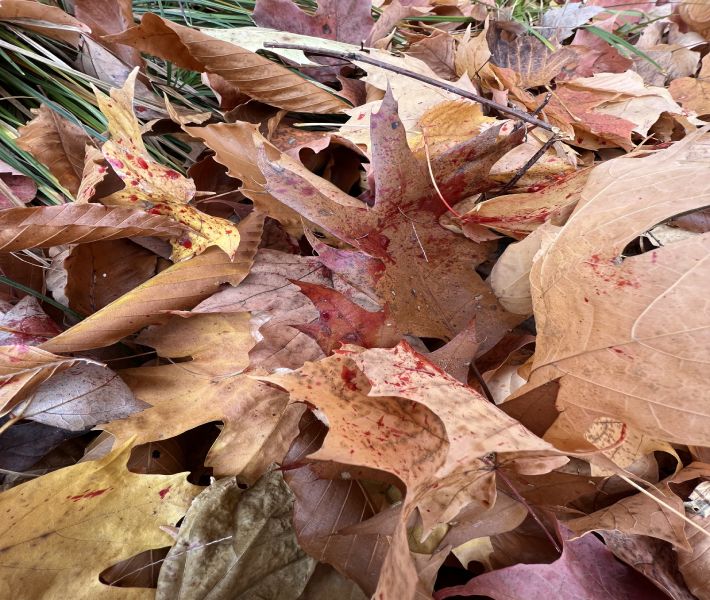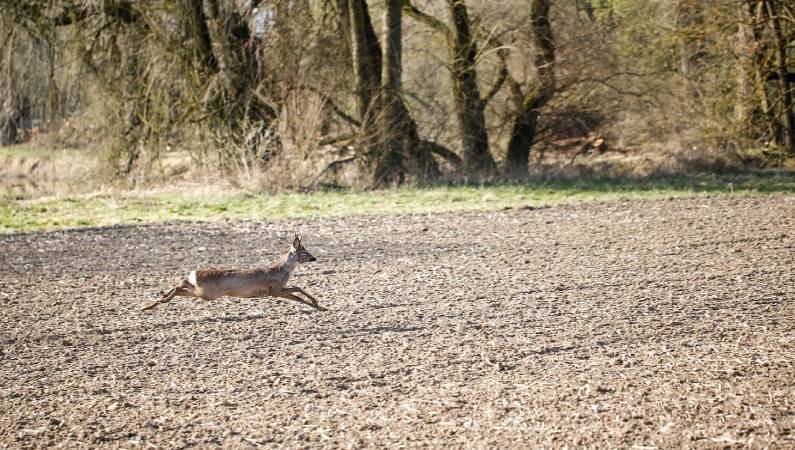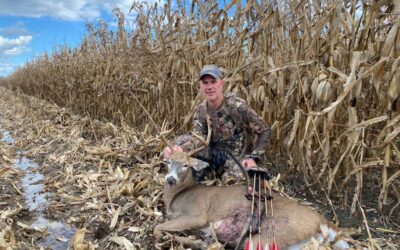This article may contain affiliate product links. I may receive a commission from sales. However, there is no extra cost to the buyer for using my affiliate link.
If you are new to The Whitetail Teacher Welcome! If you enjoy this article with friends and family members that hunt.
You can also join our community by Starting Your New Journey Today! (3 Free PDFs with exclusive content from The Whitetail Teacher)
If you have shot a whitetail deer before, you know that you now have to begin blood tracking a wounded animal. The wounded deer will have a resulting blood trail that you can Learn, Plan, and Execute to find the final resting place of your harvest.
While it is not an easy task to analyze the blood trail, make an important decision, and stick to a good strategy, it is required to succeed in blood tracking all your harvest.
Blood tracking deer properly means you need to have a basic understanding of how different shots will affect your blood trail.
Learn More >>> Whitetail Anatomy (Ensure a Lethal Shot)
This article will give you a foundation for how to blood track a whitetail deer. In a perfect world, you would always have a straight line while blood-trailing deer for roughly 50-100 yards before finding your harvested animal in its final resting place.
However, we do not live in a perfect world. We live in a world where mistakes happen, poor shot placements happen, and blood trailing your own deer can be an exhausting task.
Understand that each harvest will require you to become a better hunter. You may have a sleepless night, hours of waiting before entering the area again, and easy blood tracking.
Now that you have an understanding of what information will be covered, let us get into the nitty-gritty details so you can become the new substitute for a blood-tracking dog.
Blood Tracking Perfect Shots
A perfect shot is a great accomplishment as a hunter and will likely result in an easy blood trail to follow with lots of blood loss.
Do not be fooled through, whitetail deer are extremely relentless animals. I have to see plenty of situations on Youtube and in my personal experience to know that even with a perfect shot, deer will run hundreds of yards.
What constitutes a Perfect Shot?
Heart Shots
A heart shot is considered a perfect shot by most hunters. Often times is referred to as the “pump house.”
When you have a heart-shot deer, you can expect to start your blood tranking within an hour of the shot site.
Heart shot blood tends to be dark red blood.
It is a good idea to make sure that the blood is distinguishably red and not so dark that it looks purple or black. If it is not noticeably red, it is most likely a liver shot instead.
Double Lung Shot
A double-lung hit is also perceived to be one of the best shots you can make as a hunter. A double-lunged shot is not always possible given the position of the whitetail deer at the time.
However, when you have a double lung shot, you should be able to also track the wounded deer within an hour of your shot.
If you hunt over a lot of open fields and make a great shot, the deer will likely only make it a short distance before expiring in the open field.
In this situation, you do not even need to track the whitetail deer. You should still look at the blood type and analyze the shot for a reference point for future harvests.
All you need to do is wait about 30 minutes just to ensure that the animal is truly dead. Then you can start the gutting process.
Learn More >>> How to Gut a Whitetail Deer

Blood Tracking Other Types of Shot Placements
If you are always making perfect shots of whitetail deer, then you probably can probably close this article because you will not need to be worried about how to blood-track whitetail deer.
However, if you are like me and do not always make perfect shots on deer, then you are in the right place to learn how to strategically blood track a wounded deer.
Single Lung Shots
A single lung shot is exactly what it sounds to be. Your arrow or bullet went through only 1 lung. This is an ethical and lethal shot. It is also a better shot than any other type of hit in this part of the article.
There is almost always bright red blood with bubbles in it. These bubbles are the air inside the blood from the lungs breathing in the air but then they cough and hack up that blood. This causes a spraying look on the tree trunks and on the ground. It is kind of like taking paint and flicking it on a canvas.
The spraying blood trail is a good sign that your harvest was successful.
Liver Shot
A liver shot is still a good shot but experiencing a few liver hits bother me personally and while tracking my father’s deer, it takes much more time than a heart shot or lung shot.
The blood type tends to be dark blood. This is also extremely thick blood. If you have any doubt about the shot placement that you made, it is best to give that wounded deer lots of time to expire. If you bump a wounded whitetail deer out of its bed, it will most likely hurt you rather than help you.
Liver shots are some of the trickiest shot placements to make a decision about when to track and when to back out and wait a significant amount of time before tracking (normally 8-10 hours).
Liver-shot deer have more sparse blood trails than heart or lung-shot deer. A decent blood trail with extremely dark red blood is a good indicator of a liver hit.
Gut Shot
A guttural shot will almost always have stomach contents on the arrow (during archery season) or on the ground. If you hunt farmlands you will often see corn, soybeans, and alfalfa in the blood trail.
A gut-shot deer will most likely last a long time and you may possibly lose the deer altogether. If you find yourself in a situation where you have gut-shot a deer, the first thing you should do is take a deep breath to relax. No ethical hunter enjoys gut-shooting a deer. Nevertheless, it happens to everyone!
A gut shot is normally a good indicator that you should get out of the woods, get some food or sleep, or both before creating a game plan to blood track your deer.
All other shots
You may find yourself in a situation where you do not know if you made a good hit on a deer. Once again, do not panic.
Rather try to take in as much information as you can about the deer’s behavior. By doing this you will be able to make the best decision because you may be able to get another shot opportunity.
I hate to admit this, but I have been able to take up to 5 shots at the same deer. Only on the fifth shot was I able to make a good hit on the deer. (The story is really dumb and I was a young hunter at the time. However, I learned valuable lessons from the experience)
High Hit
A high hit will most likely go one of two ways. You will either hit the spine of the deer and drop them in their tracks. Or, you will skim above the spine and be left with a fluff of hair mixed with fatty blood.
The fatty blood kind of looks and feels like Jell-O.
The hair is normally brown from the back of a deer.
If you find these signs as a deer hunter, you do not need to worry about blood tracking that deer because they will survive. Instead, try to move on and keep hunting hard for your next shot opportunity.
Low Shots
Low hits will often result in the same type of signs as high hits. You will often find a bit of hair and fatty blood at the impact site.
The main difference is that the hair will more than likely be white from the hair on the belly of a whitetail deer.
Each situation is a little different and you want to be aware of the deer’s body language before tracking the deer.
If the deer is in a running motion and he takes a hard fall, then most likely that deer is dead.
However, if the deer stops and lays down, you may want to give that deer some more time before going to track whitetail deer.

Quick Recap of Blood Type & Time to Recover
Heart Shot Deer
- The blood color is a vibrant red with a good blood trail
- Typically will Run for 5-15 seconds
- Up to 300 yards of distance covered
- Wait 1/2 – 1 hour before recovery
Lung Shot Deer
- The blood color is bright red with bubbles with a good spraying trail.
- Typically will run for 10-20 seconds (Depending on if you hit one or two lungs)
- Up to 300 yards of distance covered
- Wait 1/2 – 1 hour before recovery
Liver Shot Deer
- The blood color is dark red with a decent blood trail
- Up to 1 hour before expiring
- Can run up to 1 mile or more if not pursued properly
- Wait at least 2-3 hours before pursuing
Gut Shot Deer
- The blood color is not good and smells and has food contents in it
- May never find your deer (but it is possible)
- Can run miles but will most likely bed down
- Wait at least 8-10 hours overnight
The key is that if you do not see the deer fall, then you want to analyze the situation based on blood at the site of impact. Then, make a decision to track whitetail deer based on that blood.
Wounded Deer Behavior
A wounded deer will go to specific areas as they are injured and its survival instincts kick into full gear. Regardless of if they get to the location they are heading to before expiring, they will head to specific locations.
Deer that are just hit with either an arrow or a gun tend to run toward where they feel safe. This could be a water source, a sanctuary, a bedding area, thick cover, and a cornfield most of the time in farm country.
The survival instincts that a deer has are already on high alert at all times. Whitetail deer are prey to humans, coyotes, mountain lions, and any other predator that may call the woods its home.
However, when a deer is wounded, its survival skills are amplified like a sports athlete on steroids. This is why what you do matters so much after you have taken your shot.
It is common that a deer will only run up to 250-300 yards before finding the safest place to create its first bed. This first bed is a crucial location for a wounded deer.
This first bed signifies where the deer will most likely stay for a long time while it tries to heal itself and get the rest that it needs.
DO NOT BUMP THEM OUT OF ITS BED EARLY!
We need to talk specifically talk about the risk factor of bumping a wounded deer out of its bed early. A lot of times deer will not use fight or flight and choose fight. At least not with predators.
If you pump a deer out of its bed, it will almost always choose flight. That flight could last for more than 1/2 mile before they feel safe enough again to bed down.
When you already have a wounded animal that is not producing a good blood trail, it is not helpful to you for the deer to continue running farther away and leaving no blood trail behind for you to track.
If you see a bad sign of blood and guts at your shot location, you should follow the GOLDEN RULE!
GOLDEN RULE: WHEN IN DOUBT, BACK OUT!
REPEAT IT WITH ME: WHEN IN DOUBT, BACK OUT!
After a wounded deer has been bumped out of its first bed roughly 100-300 yards away, they become much harder to track and your likelihood of finding that deer goes down drastically.
You do not want to lose the biggest buck of your hunting career because you were impatient.
Tracking a Whitetail Deer in the Dark
When you find yourself about to track whitetail deer in the dark, it can be way harder. In fact, without proper light, it may be impossible.
You will want a super bright light. This will help the blood stand out as a bright color against all the duller colors of the woods.
A headlamp may be a sufficient enough light for lethal shots that give a good blood trail. However, if you did not make a shot that produced a good blood trail, then you may want a better light.
Find a Great Blood Trailing Light >>> Primos Bloodhunter Tracking Light
Deer’s Reaction After Shot Meanings
An Animal’s reaction is different depending on the level of awareness they have at a given time. Their reactions at the point of impact can give you insight into your shot placement and if you pay close attention, can help you blood track your deer more efficiently.
A Mule Kick
A mule kick happens when a deer is hit and hit hard. They will jump in the air as if they are extremely startled (which they are) and kick their hind legs backward like a mule.
This normally is a great sign that the deer will expire in a reasonable time frame. After the mule kick, they will run like hell is chasing them because they know that they are severally injured.
Running Away with a Bound
If a deer runs away with its tail up and bounding away, then you most likely skimmed the deer on the lower or upper body. Not enough to find yourself with a dead deer. Not a good sign if you have a deer run away as if it just caught your wind.
Deer Does Nothing After the Shot
This means that you probably missed the deer completely. They may just at the thud of your arrow or at the sound of your gun, but if they have not spotted you, smelled you, or know that they are in danger then you may have time to get another shot opportunity.
I did in the story I kind of told earlier (I do not tell that story often).
Outliers of Blood Tracking Deer
Deer are resilient animals and they can be a pain in the butt to kill sometimes even with a great shot. Specifically, during bow hunting season, archery hunters may not get a complete pass-through (meaning the arrow goes through the deer completely)
This occasionally can cause a false blood trail that may make you believe that you made a worse hit than you actually did. The reason for that is the arrow will cause the blood to clot rather than flow freely.
Do not be too worried because within 20-30 yards the arrow will normally fall out and you will find a sufficient amount of blood to start blood tracking your deer.
I mention this because, with anything in life, there will be outliers.
Conclusion
Blood tracking deer can be easy or it can be extremely frustrating. It all depends on if you make a good lethal shot.
Learn More >>> Whitetail Anatomy (Ensure a Lethal Shot)
Each shot is unique and the blood track process is unique. Just know that whitetails are resilient animals. They are tough and will put up a good fight to survive.
I hope all your blood-tracking experiences result in a recovered deer. But, that is not likely if you hunt for any amount of time. Enjoy the challenge. Remember that you will gain years of experience and get better at blood-tracking deer as you do it more often.
Thank you for visiting The Whitetail Teacher! If you enjoyed this post, make sure to share it with a friend.
If you have any questions or recommendations for new blog posts, please use the contact form.
Learn, Plan, Execute,
The Whitetail Teacher




